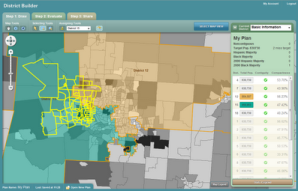 An open source program created as part of an effort to make the U.S. redistricting process more transparent was awarded one of five inaugural Strata Data Innovation Awards at last month’s O’Reilly Strata Conference, a gathering of leading minds in the emerging field of “big data.”
An open source program created as part of an effort to make the U.S. redistricting process more transparent was awarded one of five inaugural Strata Data Innovation Awards at last month’s O’Reilly Strata Conference, a gathering of leading minds in the emerging field of “big data.”
The web-based program, DistrictBuilder, was developed by the Public Mapping Project, an effort to engage the public in the redistricting process. It’s led by Dr. Micah Altman, director of research and head/scientist, Program on Information Science for the MIT Libraries at the Massachusetts Institute of Technology, and Dr. Michael P. McDonald, associate professor at George Mason University. DistrictBuilder won in the “Data Used for Social Impact” category.
Every 10 years, the U.S. performs a constitutionally mandated census, partly to determine how electoral votes and congressional districts should be apportioned based on population shifts during the prior decade. Unfortunately, partisans in state legislatures often attempt to gerrymander districts, manipulating boundaries in a way that favors their party’s incumbents over the fair representation of a contiguous community.
The politicians who draw gerrymandered districts are always cognizant of the possibility of a court challenge, notes Altman. The problem is, historically, the courts have been “limited to looking at a few plans that were submitted by partisans,” he told LJ. When challenged, these legislators can often simply argue that they couldn’t create a more competitive district, because doing so would cause the district to fail to meet a legal criteria, such as equal population.
The complexity of the process perpetuates these problems. Average citizens have never had access to the tools—such as redistricting software—needed to create a legal redistricting plan.
DistrictBuilder, an open-source GIS program developed by the Public Mapping Project and engineered by software development company Azavea through a grant from the Alfred P. Sloan Foundation, aims to simplify the process. Essentially, the software makes it easy for students, consumer and community groups, and other interested citizens to design their own redistricting maps for public submission, or just explore how the redistricting process works. Last summer, the software was used in several state and city redistricting competitions, including a New York state contest also sponsored by a grant from the Sloan Foundation.
“In the Virginia competition a 10 year old created a plan that met all of the legal criteria,” Altman said.
These competitions ultimately produced thousands of plans created by citizens. By comparison, “10 years ago, I could count on my fingers the number of redistricting plans that were publicly submitted,” he added.
The current national redistricting cycle is complete, and new congressional districts won’t be drawn for another decade. But, Altman noted that DistrictBuilder and the Public Mapping Project already helped raise awareness during the last round. The contests also helped make it possible for researchers to begin studying how plans created by the public tend to differ from plans created by professionals.
“I think it will be easier for people to participate in the next round,” Altman said. “We’ve raised an expectation.”
And whereas before, this was a nagging problem that average citizens had little recourse to address, DistrictBuilder offers ways for groups to create solutions and argue for them, he added.



We need a level playing field for speech.
One way might be public utility computing provided by library systems.
1. This would be a completely sponsorship free platform with sponsor free search.
2. End users would have complete control over the user interfaces (no modal windows etc.) every option would be opt-in by default.
3. There would be no product placement or allowing of any attempt to canalize attention just clean functional search and possibly some honest trending (again, a opt-in, privacy protected optional search element.) There would be no selling of information (this would not be about spying or interrupting) any trending would be there for all who want to see it.
4. Content would be conceptualized as communication.
We have a business first world that leads to busy work lives that begin in production oriented classroom. Our first step in fixing this is realizing that despite the internet we have a system built on mass censorship (sponsorship.) It needs a new foundation to replace sponsorship.